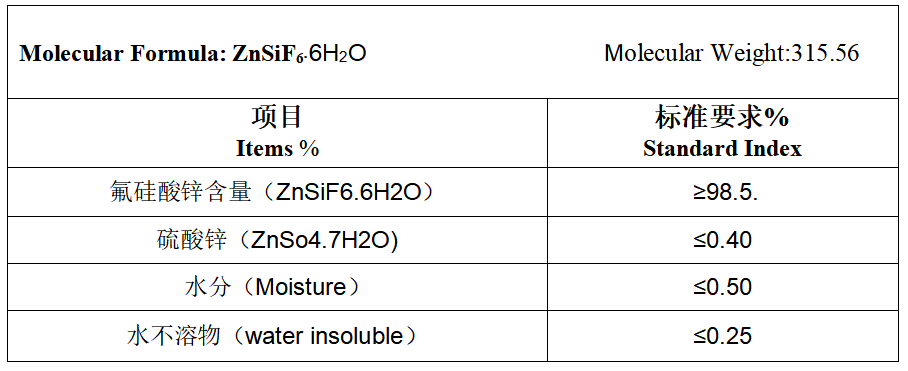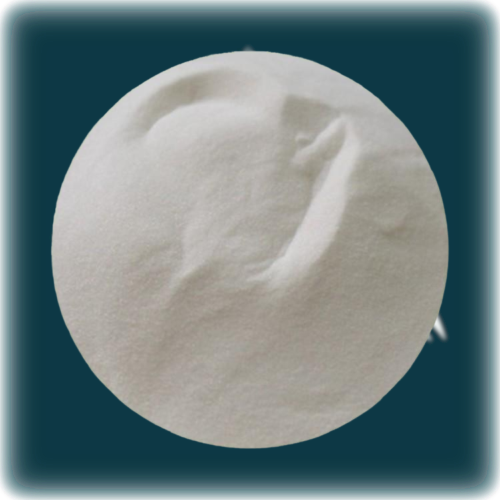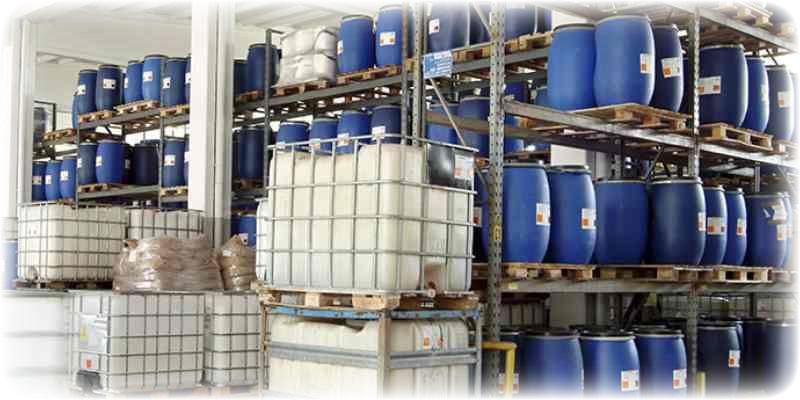Definition
Zinc Fluorosilicate, also known as zinc silicofluoride, is a chemical compound with the formula ZnSiF6. It is a colorless, odorless crystalline solid that is highly soluble in water, making it useful in a variety of applications. This essay will discuss the synonyms, formula, and applications of zinc fluorosilicate.
Firstly, zinc fluorosilicate goes by several synonyms, including zinc silicofluoride, zinc hexafluorosilicate, and hexafluorosilicic acid zinc salt. These names refer to the same chemical compound and are commonly used interchangeably. Zinc fluorosilicate is formed by the reaction of zinc oxide or zinc hydroxide with hydrofluosilicic acid.
CAS NO. 16871-71-9
Molecular Formula: ZnSiF6 6H2O
Mol. Wt: 315.54
Cas No.: 16871-71-9
UN No.: 2855
EMS No.: F-A, S-A
EINECS: 240-894-1
Synonyms: Zincsilicofluoride

The chemical formula for zinc fluorosilicate is ZnSiF6. This formula indicates that the compound is composed of one zinc atom (Zn) bonded to six fluoride atoms (F) and one silicate group, which consists of one silicon atom (Si) bonded to four oxygen atoms (O). The molecular structure of it is a tetrahedron, with the zinc atom at the center and the fluoride and silicate ions surrounding it.
Applications
This compound has a wide range of applications due to its solubility in water. One of its primary uses is as a component in electrolyte solutions for zinc plating processes. The compound helps improve the efficiency and quality of zinc plating by enhancing the adhesion and uniformity of the zinc layer. Additionally, zinc fluorosilicate is used in the production of specialty glass and ceramics. It acts as a flux, helping reduce the melting temperature of the raw materials and facilitating the formation of a smooth and uniform glass or ceramic surface.
Other Applications
Another important application of zinc fluorosilicate is in water fluoridation. The compound is added to public water supplies to prevent tooth decay by increasing the concentration of fluoride ions. Fluoride is known to strengthen tooth enamel and reduce the risk of cavities. It is an effective and economical way to deliver fluoride to the population, promoting oral health without affecting the taste, odor, or appearance of the water.
Conclusion
In conclusion, zinc fluorosilicate, also known as zinc silicofluoride, is a versatile chemical compound with the formula ZnSiF6. It is used in various industries, including zinc plating, glass and ceramics production, and water fluoridation. The compound’s solubility in water allows for easy incorporation into different processes, enhancing their efficiency and performance. The synonyms, formula, and applications of zinc fluorosilicate make it a valuable compound in many aspects of modern life.
Zinc Fluorosilicate (ZnSiF6): A Comprehensive Exploration of its Diverse Applications
Zinc Fluorosilicate, also known as ZnSiF6, emerges as a compound with a broad spectrum of applications across diverse industries, owing to its distinctive properties and versatile reactivity. This essay delves into the extensive applications of ZnSiF6, emphasizing its significance and impact on various sectors.
Introduction:
ZnSiF6, derived from the reaction between zinc oxide (ZnO) and hydrofluoric acid (HF), boasts stability and solubility in water. This essay navigates through the manifold applications of Zinc Fluorosilicate, elucidating its crucial role in various industrial processes.
Metal Surface Treatment and Corrosion Prevention:
ZnSiF6 plays a vital role in metal surface treatment, particularly in preventing corrosion. As an effective corrosion inhibitor, it forms a protective layer on metal surfaces, enhancing durability and extending the lifespan of components. Industries such as automotive and infrastructure benefit from this application in combating the effects of corrosion.
Electroplating Enhancement:
In electroplating, ZnSiF6 serves as a crucial component in electrolytes. Its addition ensures a more uniform and smoother metal deposition, enhancing the quality and aesthetics of coated products. This application is pivotal in industries like electronics and jewelry manufacturing, where precision and quality are paramount.
Catalyst in Organic Synthesis:
ZnSiF6’s catalytic properties make it an indispensable tool in organic synthesis reactions. Operating as a Lewis acid catalyst, it activates substrates, facilitating efficient and selective reactions. This catalytic role is fundamental in the production of pharmaceuticals, specialty chemicals, and polymers, contributing to the efficiency of synthetic processes.
Glass Etching Expertise:
ZnSiF6 finds application in the glass industry as an etching agent. Its ability to selectively remove thin layers of glass enables the creation of intricate designs in decorative glassware, glass art, and electronic components. This controlled etching process is vital for achieving precise and aesthetically pleasing results in various glass applications.
Concrete and Cement Additive:
In the construction industry, ZnSiF6 acts as an additive in the production of concrete and cement. Its reaction with alkaline compounds in cement contributes to the development of long-lasting and resilient infrastructure. This application enhances the strength and durability of concrete structures, ensuring their longevity and reliability.
Uranium Extraction and Nuclear Industry:
ZnSiF6 plays a crucial role in the nuclear industry, particularly in the extraction and purification of uranium. The compound reacts with uranium compounds, forming soluble complexes. This process is fundamental for the production of nuclear fuel, contributing significantly to the generation of nuclear energy.
Fluoride Production for Water Treatment:
An important application of ZnSiF6 lies in water fluoridation. Its controlled addition to water supplies aids in preventing tooth decay and promoting dental health by maintaining a consistent fluoride concentration. This widely adopted practice contributes to public health on a global scale.
Controlling Organizations and Safety:
Regulations and guidelines for the use of ZnSiF6 and other fluorine compounds are overseen by various international, national, and regional bodies. A significant organization in this regard is the International Council of Chemical Associations (ICCA), collaborating to ensure responsible chemical use and safety.
For specific regulations, individuals and organizations can refer to bodies such as the Occupational Safety and Health Administration (OSHA) in the United States and the European Chemicals Agency (ECHA) in Europe. These agencies provide comprehensive information on the safe handling, storage, and disposal of chemicals, aligning with safety and environmental standards.



